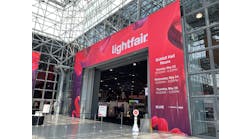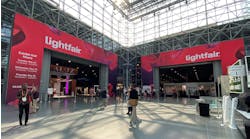In a session held Tuesday, March 9 from 2 p.m. to 3 p.m., two industry experts (Kelly Cunningham of Pacific Gas & Electric and Michael Jouaneh of Lutron Electronics Co., Inc.) gave Lightfair attendees fresh perspectives on three energy codes. As the commercial building industry moves toward zero net energy goals, they explained why lighting controls play such a critical role in energy use reduction.
The current versions of three well-known codes (ASHRAE 90.1-2016, IECC 2015, and Title 24, Part 6 2016) contain significant lighting controls measures using similar strategies. As widespread adoption of energy codes takes place, the use of lighting controls has become the norm rather than the exception. This presentation helped attendees learn how to comply with, or exceed, the requirements.
What’s new in ASHRAE 90.1-2016? According to presenters, some of the highlights include dwelling units must use high-efficiency lighting or controls like dimmers or sensors. Alterations of more than 20% of the lighting load must also meet nearly all the mandatory lighting control requirements as done for new construction, partial-off occupancy sensor control is now required for parking lot lighting polls 24 ft or less above the ground, and new LPDs reflect more use of LED lighting (mostly lower LPDs from 90.1-2013).
What’s new in IECC 2015? For one thing, the lighting chapter has been clarified. Automatic daylight responsive control is required, as is continuous daylight dimming in some spaces like offices and classrooms. Also new is automatic shutoff of lighting in guestrooms and automatic partial-off lighting in warehouse aisles and open areas. There is also an added enhanced digital lighting controls efficiency option.
What’s new in Title 24, Part 6 2016? New LPDs reflect increased used of LED lighting. For spaces that require dimming and occupancy sensors, partial-ON or vacancy sensor is required. In addition, 0.2W/ft2 of egress lighting in any building type may remain on during occupied hours and 0.1 W/ft2 during unoccupied times. Lighting controls acceptance testing for less than 20 controlled luminaires is not required, most alterations of less than 70 luminaires per year do not trigger the compliance process, and an option to bypass controls in corridors and stairwells was added for some retrofits that reduce the lighting power by at least 35% or 50%.
Presenters also gave attendees a glimpse of what’s in store for future editions of the codes (IECC 2018, ASHRAE 90.1-2019, and Title 24 2019), some topics of which include fixtures with embedded sensors, OCC sensing requirements (at least partial-off ones) for open offices, lower LPDs based on all LED lighting, continuous daylight dimming, and institutional tuning and or lumen maintenance efficiency options.




